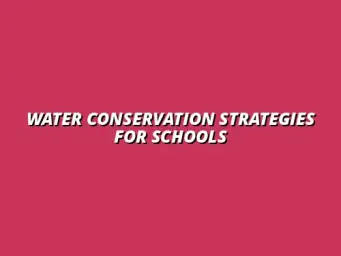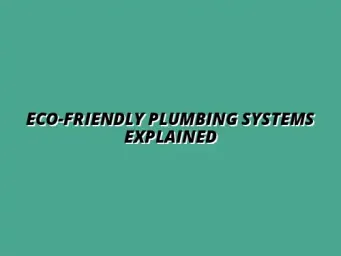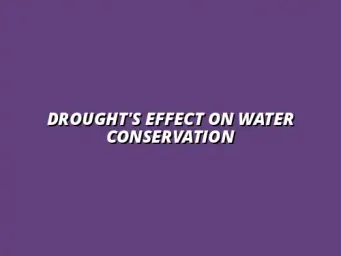Understanding Water Consumption in Households
Water is a vital resource in every household, and understanding how much we consume is crucial for both the environment and our wallets. By keeping track of our water usage, we can identify ways to conserve, making a positive impact on our surroundings and reducing our bills. Awareness is the first step toward responsible water consumption!
Many people overlook their daily water habits, often assuming that they use less than they actually do. It's essential to monitor this consumption regularly, as it enables us to spot trends and make informed decisions about our water usage. Plus, small changes can lead to significant savings over time! For more tips on reducing water waste in your daily routine, check out these daily water saving tips.
The Importance of Monitoring Water Usage
Monitoring water usage is not just about saving a few bucks; it’s about protecting our precious environment. By understanding how much water we use, we can work toward reducing waste. This practice is essential for conserving our planet's resources and ensuring a sustainable future for generations to come.
Moreover, keeping an eye on our water consumption can lead to financial benefits. Knowing your water habits allows you to identify leaks and over-usage that could be costing you more than necessary. It's a win-win situation when we focus on both environmental and financial aspects! Regular water pressure checks can help identify potential leaks early on.
Environmental Impact of Excessive Water Consumption
Excessive water consumption can lead to severe environmental issues, including water scarcity and habitat destruction. When we use more water than necessary, it can strain local water supplies, affecting wildlife and natural ecosystems. By being mindful, we can help preserve these vital resources.
Furthermore, when water is overused, it can lead to increased energy consumption, especially for heating water. This, in turn, contributes to greenhouse gas emissions, aggravating climate change. Reducing our water consumption is crucial if we want to make a difference! Regular water heater maintenance can also help reduce energy waste.
Financial Benefits of Reducing Water Usage
Saving water can significantly lower your utility bills. When you use less water, you not only pay less for water itself but also for the energy needed to heat it. This reduction can lead to substantial savings over time, making it a smart financial choice!
Here are some of the key financial benefits of reducing water usage:
- Lower water bills each month
- Reduced energy costs for heating water
- Less wear and tear on plumbing and appliances, which can lead to lower maintenance costs
With these benefits in mind, it becomes clear that monitoring and reducing our water consumption is not just good for the planet but also for our pockets! Learn more about conserving water in your bathroom to maximize savings.
Identifying Your Water Consumption Patterns
Understanding your water consumption patterns is a crucial step toward responsible usage. This means taking a close look at how, when, and why you use water in your home. By identifying these patterns, you can find areas where you can cut back!
Not only can recognizing your water habits help you save money, but it can also lead to more conscious choices about how you use water daily. Let’s dive deeper into how we can effectively read our water bills and utilize water meters! Consider installing a water-saving showerhead to make a significant impact.
How to Read Your Water Bill Effectively
Your water bill is a treasure trove of information! It provides insights into your consumption trends and can help you identify any sudden increases in usage. Knowing how to interpret the bill is key to managing your water use effectively.
Here’s how to read your water bill:
- Check the total usage for the billing period.
- Compare the current bill to previous months to spot trends.
- Look for any unusual spikes in usage that may indicate a leak.
By understanding your water bill, you can take proactive steps to conserve water and save money!
Identifying Usage Trends and Anomalies
Spotting trends and anomalies in your water consumption can help you make informed decisions about conservation. For instance, if you notice that your water usage spikes during certain months, it may be time to assess what activities are causing the increase.
In order to identify these trends, consider:
- Tracking your water usage over several months.
- Noting seasonal changes, like increased use during summer watering.
- Watching for patterns related to specific events, like house guests.
These insights can guide you in modifying your habits for better water efficiency!
Calculating Daily and Monthly Water Use
Knowing how to calculate your daily and monthly water usage is essential for effective monitoring. This can help you identify if you’re using more water than average and where adjustments can be made. It’s a straightforward process that can yield crucial insights!
To calculate your usage:
- Record the total amount of water used from your bill.
- Divide that number by the number of days in the billing period for daily usage.
- Compare your daily average to national averages to see where you stand.
With this knowledge, you’ll be empowered to implement effective water-saving measures! For additional water-saving tips for homeowners, visit this helpful resource.
Using Water Meters for Accurate Monitoring
Water meters are an excellent way to accurately monitor your household water usage. They provide real-time feedback, which can help you adjust your habits and reduce waste. Knowing exactly how much water you use can be a game-changer!
There are various types of water meters available, catering to different needs and preferences. Let’s explore the options and discover how to make the most of them!
Types of Water Meters for Home Use
When it comes to home water meters, homeowners have several options to choose from. These devices range from basic mechanical meters to advanced smart meters. Understanding the types can help you choose the right one for your needs!
- Mechanical Meters: These are traditional meters that measure water flow with moving parts.
- Digital Meters: These provide an easy-to-read digital display and can sometimes store usage data.
- Smart Water Meters: These connect to your home Wi-Fi and allow for remote monitoring and alerts.
By selecting the appropriate meter, you can gain better control over your water usage!
How to Install and Use a Smart Water Meter
Installing a smart water meter can enhance your ability to monitor usage. While the installation process can vary depending on the model, many are designed for easy installation. Here’s a simple guide to get started!
- Check local regulations on meter installation.
- Select a suitable location for the meter, typically near the main water line.
- Follow the manufacturer’s instructions for installation.
- Connect the meter to your home Wi-Fi for remote monitoring.
Once set up, using a smart water meter can help you track your water consumption effortlessly!
Monitoring Progress and Adjusting Strategies
Once you have started reducing water consumption, it’s essential to monitor your progress. Tracking your water usage can help you see which strategies are working and where you might need to adjust. By setting up a reliable tracking system, you can celebrate successes and identify areas still needing improvement.
Regularly reviewing your water consumption data can motivate everyone in your household to stay committed to your conservation goals. This ongoing evaluation helps ensure that efforts to save water become a regular part of your daily life!
Setting Up a Water Usage Tracking System
There are various tools available to help you keep track of your household's water consumption effectively. These tools can range from simple manual entries to advanced apps that provide real-time data. Here are some options to consider:
- Water Meter Readings: Take regular readings from your water meter to track usage over time.
- Mobile Apps: Use apps like WaterSave or MyWater to log and analyze your water consumption.
- Spreadsheets: Create a simple spreadsheet on your computer to log your water bill amounts and usage trends.
Using these methods can help you visualize your water usage and encourage better habits. The more data you collect, the easier it will be to see patterns and make informed decisions about your consumption.
Tools and Apps for Monitoring Home Water Consumption
With the right tools and apps, tracking water usage can be straightforward and engaging. Popular options include:
- Waterfox: Tracks daily water usage and suggests conservation tips based on your habits.
- Dropcountr: Provides insights into your usage compared to the average household in your area.
- WaterSmart: Offers personalized reports and recommendations to reduce consumption.
By leveraging technology, you can stay motivated and aware of your water consumption. This insight can lead to more mindful behaviors around water use.
How to Analyze Data and Identify Improvement Areas
Analyzing your water usage data is critical to understanding where you can improve. Start by reviewing your monthly water bills to spot trends and fluctuations. Look for peaks or spikes in usage that can indicate areas for further investigation.
Consider creating a simple chart to visualize your data over time. This visual representation can highlight:
- Seasonal changes in water use.
- Unexplained increases in consumption.
- Progress towards your conservation goals.
Identifying these areas helps you adjust your strategies effectively to conserve more water. Remember, small changes can lead to significant results!
Community Resources and Programs for Water Conservation
Engaging with community resources can enhance your efforts to conserve water. Many local utilities offer programs to help residents become more water-efficient. These programs often provide valuable information, tools, and incentives for reducing water usage. For example, you can often find local plumbers who specialize in water conservation and can help you assess your home’s plumbing for leaks and inefficiencies. Finding a reliable plumber can be a great first step.
Participating in community initiatives can also create a supportive environment to share ideas and experiences. It’s about working together for a sustainable future!
Local Utilities and their Water Efficiency Programs
Many local water utilities offer a range of programs designed to help residents save water. These services can include:
- Water audits to assess usage and recommend improvements.
- Rebates for installing water-efficient appliances or fixtures.
- Workshops on water conservation techniques.
Check your local utility's website for information on available programs. These resources can kickstart your journey toward water conservation!
Participating in Community Initiatives for Sustainable Water Use
Engaging in community initiatives can foster a sense of teamwork in water conservation efforts. Look for opportunities such as:
- Local clean-up events focusing on water bodies.
- Workshops on landscaping for water efficiency.
- Community challenges or competitions for reducing water usage.
By participating, you not only learn new strategies but also inspire others in your community to take action. Together, we can make a difference!
Addressing Common Questions about Water Conservation
As you dive into water conservation, questions may arise about best practices and potential areas for improvement. Understanding common sources of water waste and effective strategies to reduce usage is vital. Let’s explore some of these questions!
What are the Most Common Sources of Water Waste at Home?
Identifying where water waste occurs in your household can lead to significant savings. Some of the most common sources include:
- Leaky faucets and toilets that can waste gallons daily.
- Overwatering lawns and gardens, leading to runoff.
- Long showers and excessive use of water during dishwashing.
By focusing on these areas, you can make immediate changes that will impact your water usage positively.
How Can I Educate My Family About Water Conservation?
Educating your family about water conservation is crucial for fostering long-term habits. Here are some simple ways to get everyone involved:
- Hold family discussions about the importance of saving water.
- Set up friendly competitions to see who can save the most water.
- Create a family water conservation plan with specific goals.
By making it a family affair, you’ll not only save water but also build lasting values around conservation!
Encouraging Long-Term Water-Conserving Habits
Building sustainable practices in your household starts with commitment and consistency. Encourage your family to keep these habits alive by creating a family water conservation plan. This structured approach can guide everyone as a team!
Creating a Family Water Conservation Plan
Your family water conservation plan should outline clear goals and strategies. Consider including:
- Specific water-saving targets for each month.
- Assigning responsibilities to each family member.
- Regular check-ins to discuss progress and challenges.
By establishing a structured plan, you can ensure everyone is on the same page and committed to conserving water.
Involving Children in Water-Saving Activities
Getting children involved can make water conservation fun and educational! Here are some activities to consider:
- Organizing a “water-saving” week with challenges.
- Creating crafts from recycled materials to promote sustainability.
- Teaching them about plants that require less water.
Involving kids helps them understand the value of water and encourages them to develop lifelong conservation habits.
Regularly Reviewing and Updating Water Usage Goals
To ensure progress toward your water-saving goals, make it a habit to review your plan regularly. Set a monthly reminder to evaluate how you have done and adjust your strategies as necessary. This will keep your family engaged and accountable!
Charts or graphs can be helpful in visualizing your water usage trends over time. Celebrating milestones as a family can also motivate everyone to stay committed!
Final Thoughts on Sustainable Water Practices
In summary, sustainable water practices are crucial for preserving this precious resource. Individual contributions matter, and every effort counts towards making a significant impact on water conservation!
Emphasizing the Importance of Individual Contributions
Each person’s commitment to saving water can lead to collective change. When families and communities work together, the cumulative effect of individual actions can be incredibly powerful. Remember, even small changes can lead to big results!
Encouraging Continued Education on Water Conservation Methods
Finally, keep the conversation about water conservation going! Stay informed about new methods and technologies that can further enhance your efforts. Sharing newfound knowledge with your family and community can inspire others to join your journey toward sustainable water use!










